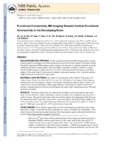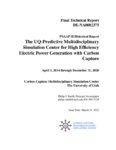Filters: Collection: "ir_uspace"
| Creator | Title | Description | Subject | Date | ||
|---|---|---|---|---|---|---|
| 176 |
 | Hansen, Charles D. | Physically-based interactive schlieren flow visualization | Understanding fluid flow is a difficult problem and of increasing importance as computational fluid dynamics produces an abundance of simulation data. Experimental flow analysis has employed techniques such as shadowgraph and schlieren imaging for centuries which allow empirical observation of inho... | 2010-03 | |
| 177 |
 | Berzins, Martin | Systematic debugging methods for large-scale HPC computational frameworks | Parallel computational frameworks for high-performance computing are central to the advancement of simulation-based studies in science and engineering. Finding and fixing bugs in these frameworks can be time consuming. If left unchecked, these bugs diminish the amount of new science performed. A sys... | 2014-01-01 | |
| 178 |
 | Myers, Chris J. | Timed circuit synthesis using implicit methods | The design and synthesis of asynchronous circuits is gaining importance in both the industrial and academic worlds. Timed circuits are a class of asynchronous circuits that incorporate explicit timing information in the specification. This information is used throughout the synthesis procedure to... | 1999 | |
| 179 |
 | Hansen, Charles D. | Multidimensional transfer functions for interactive volume rendering | Abstract-Most direct volume renderings produced today employ one-dimensional transfer functions which assign color and opacity to the volume based solely on the single scalar quantity which comprises the data set. Though they have not received widespread attention, multidimensional transfer function... | 2002-07 | |
| 180 |
 | Hansen, Charles D.; Johnson, Christopher R. | Constraint-based technique for haptic volume exploration | We present a haptic rendering technique that uses directional constraints to facilitate enhanced exploration modes for volumetric datasets. The algorithm restricts user motion in certain directions by incrementally moving a proxy point along the axes of a local reference frame. Reaction forces are g... | Haptic rendering; Immersive visualization; Human-computer interaction | 2003 |
| 181 |
 | Parker, Steven G.; Hansen, Charles D. | Distributed interactive ray tracing for large volume visualization | We have constructed a distributed parallel ray tracing system that interactively produces isosurface renderings from large data sets on a cluster of commodity PCs. The program was derived from the SCI Institute's interactive ray tracer (*-Ray), which utilizes small to large shared memory platforms, ... | Ray tracing; Volume rendering; Large data; Cluster computing; Distributed shared memory | 2003 |
| 182 |
 | Hansen, Charles D. | Interactive texture-based volume rendering for large data sets | Visualization is an integral part of scientific computation and simulation. State-of-the-art simulations of physical systems can generate terabytes to petabytes of time-varying data where a single time step can contain more than a gigabyte of data per variable. As memory sizes continue to increase, ... | Parallel rendering; Volume rendering; TRex | 2001 |
| 183 |
 | Hansen, Charles D. | Interactive translucent volume rendering and procedural modeling | Direct volume rendering is a commonly used technique in visualization applications. Many of these applications require sophisticated shading models to capture subtle lighting effects and characteristics of volume metric data and materials. Many common objects and natural phenomena exhibit visual qua... | Volume rendering; Volume visualization; Direct volume rendering; Multidimensional transfer functions; Direct manipulation widgets; Graphics hardware | 2002 |
| 184 |
 | Gerig, Guido | Temporal and spatial development of axonal maturation and myelination of white matter in the developing brain | BACKGROUND AND PURPOSE-Diffusion tensor imaging (DTI) has been widely used to investigate the development of white matter (WM). However, information about this development in healthy children younger than 2 years of age is lacking, and most previous studies have only measured fractional anisotropy (... | 2009-01-01 | |
| 185 |
 | Horch, Kenneth W. | Closed loop control of ankle position using muscle afferent feedback with functional neuromuscular stimulation | This paper describes a closed-loop functional neuromuscular stimulation system that uses afferent neural activity from muscle spindle fibers as feedback for controlling position of the ankle joint. Ankle extension against a load was effected by neural stimulation through a dual channel intrafasc... | Neuromuscular stimulation; Functional neuromuscular stimulation (FNS); Neural electrodes | 1996 |
| 186 |
 | Tasdizen, Tolga; Whitaker, Ross T. | Curvature-based transfer functions for direct volume rendering: methods and applications | Direct volume rendering of scalar fields uses a transfer function to map locally measured data properties to opacities and colors. The domain of the transfer function is typically the one-dimensional space of scalar data values. This paper advances the use of curvature information in multi-dimensio... | 2003 | |
| 187 |
 | Gerig, Guido | Functional connectivity MR imaging reveals cortical functional connectivity in the developing brain | BACKGROUND AND PURPOSE: Unlike conventional functional MR imaging where external sensory/cognitive paradigms are needed to specifically activate different regions of the brain, resting functional connectivity MR imaging acquires images in the absence of cognitive demands (a resting condition) and de... | 2008-01-01 | |
| 188 |
 | Hansen, Charles D.; Wald, Ingo | Interactive ray tracing of arbitrary implicits with SIMD interval arithmetic | We present a practical and efficient algorithm for interactively ray tracing arbitrary implicit surfaces. We use interval arithmetic (IA) both for robust root computation and guaranteed detection of topological features. In conjunction with ray tracing, this allows for rendering literally any progr... | 2007-09 | |
| 189 |
 | Tasdizen, Tolga; Whitaker, Ross T. | Particle-based simulation of fluids | Due to our familiarity with how fluids move and interact, as well as their complexity, plausible animation of fluids remains a challenging problem. We present a particle interaction method for simulating fluids. The underlying equations of fluid motion are discretized using moving particles and th... | 2003 | |
| 190 |
 | Hansen, Charles D. | Proxy chain method and its application to scientific visualization | We present a method for combining multiple point-based constraints in haptic programming environments. Instead of using a single proxy point for haptic feedback, the method maintains a separate proxy for each constraint. The reaction force is computed by linking the proxies in a chain. Constraints a... | 2006 | |
| 191 |
 | Gerig, Guido | Teasing apart the heterogeneity of autism: Same behavior, different brains in toddlers with fragile X syndrome and autism | To examine brain volumes in substructures associated with the behavioral features of children with FXS compared to children with idiopathic autism and controls. A cross-sectional study of brain substructures was conducted at the first time-point as part of an ongoing longitudinal MRI study of brain ... | 2009-01-01 | |
| 192 |
 | Freire, Juliana; Silva, Claudio T. | VisTrails: enabling interactive multiple-view visualizations | VisTrails is a new system that enables interactive multiple-view visualizations by simplifying the creation and maintenance of visualization pipelines, and by optimizing their execution. It provides a general infrastructure that can be combined with existing visualization systems and libraries. A ke... | VisTrails; Dataflows; Pipelines; Provenance management; Interrogative visualization; Caching; Coordinated views | 2005 |
| 193 |
 | Smith, Philip J. | The UQ-predictive Multidisciplinary Simulation Center for high efficiency electric power generation with carbon capture | The University of Utah Multidisciplinary Simulation Center was established in April of 2014 by the United States Department of Energy, National Nuclear Security Administration (NNSA)for the purpose of developing and demonstrating the use of formal uncertainty quantification (UQ) methodologies in con... | digital twin; biomass boiler; Bayesian analysis; uncertainty quantification; high performance computing; continuous optimization | 2021-03-31 |
| 194 |
 | Bargteil, Adam Wade | Animation of deformable bodies with quadratic bézier finite elements | In this article, we investigate the use of quadratic finite elements for graphical animation of deformable bodies.We consider both integrating quadratic elements with conventional linear elements to achieve a computationally efficient adaptive-degree simulation framework as well as wholly quadratic ... | 2014-01-01 | |
| 195 |
 | Hansen, Charles D. | Boundary aware reconstruction of scalar fields | In visualization, the combined role of data reconstruction and its classification plays a crucial role. In this paper we propose a novel approach that improves classification of different materials and their boundaries by combining information from the classifiers at the reconstruction stage. Our ap... | 2014-01-01 | |
| 196 |
 | Mower, Allyson | Exploring publishing patterns at a large research university: Implications for library practice | Objective - The research project sought to explore the value of data on publication patterns for decision-making regarding scholarly communications and collection development programs at a research-intensive post-secondary institution, the University of Utah in the United States. Methods - Publicati... | 2012-01-01 | |
| 197 |
 | Hansen, Charles D. | Gaussian transfer functions for multi-field volume visualization | Volume rendering is a flexible technique for visualizing dense 3D volumetric datasets. A central element of volume rendering is the conversion between data values and observable quantities such as color and opacity. This process is usually realized through the use of transfer functions that are prec... | Volume rendering; Transfer functions; Volume visualization | 2003 |
| 198 |
 | Hansen, Charles D. | Interactive volume rendering using multi-dimensional transfer functions and direct manipulation widgets | Most direct volume renderings produced today employ one-dimensional transfer functions, which assign color and opacity to the volume based solely on the single scalar quantity which comprises the dataset. Though they have not received widespread attention, multi-dimensional transfer functions are a ... | Volume rendering; Volume visualization; Direct volume rendering; Multidimensional transfer functions; Direct manipulation widgets; Graphics hardware | 2001 |
| 199 |
 | Hansen, Charles D. | Interactive volume rendering using multi-dimensional transfer functions and direct manipulation widgets | Most direct volume renderings produced today employ onedimensional transfer functions, which assign color and opacity to the volume based solely on the single scalar quantity which comprises the dataset. Though they have not received widespread attention, multi-dimensional transfer functions are a v... | Volume rendering; Volume visualization; Direct volume rendering; Multidimensional transfer functions; Direct manipulation widgets; Graphics hardware | 2001 |
| 200 |
 | Parker, Steven G. | Massively parallel software rendering for visualizing large-scale data sets | For some time, researchers have done production visualization almost exclusively using high-end graphics workstations. They routinely archived and analyzed the outputs of simulations running on massively parallel supercomputers. Generally, a feature extraction step and a geometric modeling step t... | Parallel rendering; Volume rendering; Ray tracing; Isosurfacing | 2001 |
